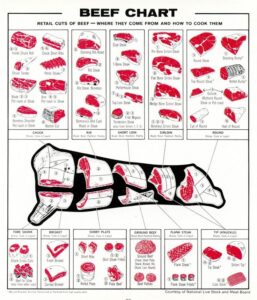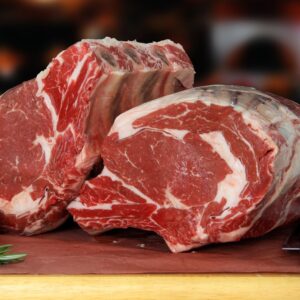A Guide to the Cuts of Beef Part One

The Purpose of the Post:
Have you ever wondered about the diverse array of cuts that can be sourced from a single cow (steer)? This blog post is dedicated to unraveling the mystery surrounding the various cuts of beef. There are several compelling reasons for delving into this subject. Firstly, many consumers are unaware of the existence of certain cuts that rival the tenderness of renowned options like the filet mignon yet come without the hefty price tag. From the savory flat iron steak to the juicy tri-tip roast, these underrated cuts offer exceptional flavor and value. Secondly, I firmly believe that an informed consumer is a smarter consumer. Armed with knowledge about different cuts, you may find yourself more knowledgeable, or as knowledgeable as the butcher behind the counter at your local shop. Whether you’re purchasing meat by the quarter or the half, this post aims to equip you with the necessary information to ensure you receive the cuts of beef that best suit your preferences and culinary needs.
The Basics:
Let’s start with the basics of explaining the cuts of meat that come from a cow (steer). To an American butcher there are Eight (8) parts of a cow (steer) that they organize their cuts from. These are referred to as the Eight (8) primal cuts of beef and they are listed below.
- Chuck
- Rib
- Loin
- Round
- Flank
- Plate
- Brisket
- Shank
Within the Eight (8) primal cuts of meat, there are “sub-primal cuts” that play a crucial role in the culinary landscape. Sub-primal cuts, as the term suggests, are sections of meat obtained by further dividing the primary cuts of beef into smaller portions. These cuts bridge the gap between the large primal cuts and the individual retail cuts that we encounter at the butcher or supermarket. While larger than retail cuts, they’re smaller and more manageable than the primary cuts. For instance, consider the beef tenderloin, a sub-primal cut renowned for its tenderness and versatility. Other examples include the flavorful ribeye roast and the hearty chuck roast. These sub-primal cuts are typically sourced from specific regions of the carcass, such as the loin, rib, chuck, round, and flank. Each sub-primal cut contains muscles with similar characteristics and cooking requirements. Understanding these cuts is invaluable for both professionals and home cooks alike, as it provides flexibility in cooking and menu planning. So, whether you’re a seasoned chef or an aspiring home cook, exploring the world of sub-primal cuts can open up a myriad of culinary possibilities.
The characteristics of sub-primal cuts:
The characteristics of sub-primal cuts exhibit consistent qualities within their respective categories, offering a diverse array of options for culinary exploration. For example, cuts from the loin region, such as the tenderloin and T-bone steak, are known for their exceptional tenderness and subtle flavor profile. On the other hand, sub-primal cuts from the chuck, such as the chuck roast and blade steak, boast robust flavors but may require longer cooking times to achieve optimal tenderness. Similarly, cuts from the round region, such as the top round and bottom round, are lean and well-suited for slow cooking methods like braising or roasting. Meanwhile, sub-primal cuts from the brisket and plate regions, such as brisket and skirt steak, offer rich, beefy flavors ideal for marinating and grilling. Understanding these characteristics empowers home cooks and chefs alike to select the most suitable cuts for their culinary creations and experiment with a variety of cooking techniques to enhance flavor and texture.




the usage of sub-primal cuts:
Exploring the usage of sub-primal cuts sheds light on their integral role in the culinary world. Chefs, butchers, and meat processors rely on these cuts to create retail cuts for consumers and to prepare large portions for commercial kitchens. From succulent ribeye steaks to flavorful pot roasts, sub-primal cuts serve as the building blocks for a wide range of dishes across diverse cuisines. These cuts can be further trimmed and portioned according to desired specifications, offering flexibility in both preparation and presentation. For example, the versatile flank steak can be thinly sliced for stir-fries or marinated and grilled whole for fajitas. Similarly, the brisket cut, known for its rich flavor and tender texture, is often slow-cooked to perfection for barbecue or braised for hearty stews. By understanding the usage of sub-primal cuts, home cooks can unlock a world of culinary possibilities and elevate their cooking to new heights of flavor and creativity.




Sub-Primal Cut Examples:
Now that we have explored what a sub-primal cut is along with its characteristics and usage, let’s delve into some specific examples. Common sub-primal cuts include the beef tenderloin, known for its exceptional tenderness and often referred to as the “filet mignon” when portioned into steaks from the loin region. The ribeye roast, sourced from the rib primal, boasts rich marbling and intense flavor, making it a favorite for roasting or grilling. From the chuck primal comes the flavorful chuck roast, perfect for slow-cooking to tender perfection in stews or pot roasts. The top round, hailing from the round primal, is lean and well-suited for roasting or slicing thinly for sandwiches. Finally, the skirt steak, originating from the flank, offers robust beefy flavor and is ideal for marinating and grilling for dishes like fajitas or carne asada. These examples represent just a glimpse of the diverse range of sub-primal cuts available, each offering its own unique characteristics and culinary potential.



Understanding A Half Side of beef:
It is crucial to understand that a half side of beef is subdivided into the front quarter and the hind quarter. Typically, the cutting process begins with the front quarter. A cow (steer) has thirteen ribs per side, totaling twenty-six ribs. The initial cut made by the butcher or meat processor separates the chuck from the rib and plate sections by slicing across the carcass between the 5th and 6th ribs. For the purpose of this discussion, let’s set aside the chuck and focus on the rib and plate section. The butcher or beef processor then proceeds to remove the skirt steak from this section, utilizing a very sharp six-to-eight-inch boning knife. Following this, the butcher or meat processor employs a band saw to separate the Plate from the Rib, a step that will be further elaborated upon later in this blog post or in a future one, space permitting. The Rib Steaks are then separated from the Beef Ribs. The butcher or meat processor carefully trims the outer layer of fat attached to the Beef Ribs with a knife and cleans as much of the fat from the ribs as possible.
The beef rib:
I want to note that the Beef Rib can be referred to as a Rib Roast, Ribeye Steaks, or Rib Steaks. The difference between Rib Steaks and Ribeye Steaks is that Ribeye Steaks are boneless, whereas Rib Steaks are bone-in. To provide a clearer understanding of the Beef Rib, I will cover all three variations either in this blog post or in the next blog post to come.
The first step in preparing the Beef Rib is for the butcher or meat processor to remove the small bone running the length of the Beef Rib, which is referred to as the ‘backstrap’ or the ‘chine bone,’ typically using a band saw. Once the ‘backstrap’ or ‘chine bone’ is removed, the Rib Section is ready to be trimmed.
The initial trimming process involves removing the ‘feather bones’ or ‘featherbones.’ These thin and cartilaginous bones are typically trimmed away to enhance the presentation and eating experience of the final rib cuts, such as ribeye steaks or prime rib roasts.
Next, the butcher or meat processor will carefully remove the fat cap from the beef rib, located on the outer surface of the rib roast or ribeye steak. This layer of fat contributes to flavor and moisture during cooking. While some chefs prefer to leave a thin layer of fat for enhanced flavor and juiciness, others may trim it more closely for a leaner presentation. Skilled butchers are particularly careful during this process to preserve the spinalis muscle, also known as the ribeye cap. Highly prized for its tenderness and flavor, the spinalis muscle remains intact through precise knife techniques. This ensures that the ribeye steak retains its marbling and flavor profile, providing consumers with a superior eating experience.



Let's talk spinalis:
When the butcher removes the fat cap from the rib roast, it’s important to understand that this is not the Spinalis. The Spinalis is a highly prized and flavorful muscle situated on the outer edge of the ribeye steak. Sometimes referred to as the “ribeye cap” due to its location and shape, this cut boasts exceptional marbling, resulting in incredible tenderness and flavor when cooked. Renowned for its rich flavor and melt-in-your-mouth texture, the spinalis is among the most coveted parts of the ribeye steak. Chefs and steak enthusiasts often seek out ribeye steaks with a generous portion of spinalis for an exceptional dining experience.
what is Paddywack:
The butcher will continue trimming the beef rib, proceeding to remove the paddywack. This term typically refers to the same part of the anatomy as the “knuckle bone” or “cartilage bone” found on beef ribs. It’s the bony cartilage located at the end of the rib bones where they attach to the spine or sternum of the animal. While not typically consumed directly, it can infuse flavor into soups, stews, or stocks when cooked slowly and may even be enjoyed by pets due to its chewy texture. However, it’s important to note that this part is often removed or trimmed during the butchering process before retail sale. Once the “ribeye cap” and the paddywack are removed, the bone-in beef rib section trimming is complete.
Starting with the bone-in beef rib:
As mentioned earlier, this post will focus on three sections of the bone-in beef rib: the Rib Roast, Ribeye Steaks, and Rib Steaks. It’s important to note that a standard bone-in beef rib typically consists of 7 ribs, often referred to as a “7-bone rib roast” or “7-rib roast.” However, the exact number of ribs can vary depending on factors such as the size of the animal and the specific butchering practices of the establishment. The butcher or meat processor has the option to sell the Rib Roast as-is or to cut it into sections. For the purpose of this blog post, we’ll focus on the butcher or meat processor cutting a three-bone-in Rib Roast by counting three ribs from the end of the bone-in rib roast.

The rib steak:
A small portion of the remaining bone-in rib roast will be used to cut three Rib Steaks, each measuring an inch and three-quarters thick. It’s crucial to differentiate between Rib Steaks and Ribeye Steaks; while Rib Steaks are bone-in cuts, Ribeye Steaks are boneless. Typically, the butcher or meat processor will use a bandsaw to separate the Rib Steaks. The thickness of the Rib Steaks is determined by the butcher or meat processor; in our case, as mentioned, they will be cut to an inch and three-quarters thick. When using a bandsaw, the butcher or meat processor will cut directly through the rib to obtain the Rib Steaks.

The Ribeye steak:
To extract the Ribeye Steaks from the remaining portion of the bone-in prime rib, the butcher or meat processor will employ a very sharp boning knife, typically around 8 inches in length. The initial step involves removing the back ribs. Additionally, some of the fat located under the back ribs towards the smaller end of the bone-in prime rib will be trimmed. Subsequently, using a larger knife, the butcher or meat processor will proceed to cut the Ribeye Steaks to a thickness of about one and a quarter to one and a half inches.

In Closing:
In conclusion, this blog post has explored the importance of understanding the diverse cuts of beef, empowering consumers to make informed choices when purchasing meat. We discussed the Eight Primal Cuts and their role in organizing butcher processes, as well as the significance of sub-primal cuts in culinary applications. These cuts bridge the gap between large primal cuts and individual retail portions, offering versatility and consistent quality.
We delved into how chefs, butchers, and meat processors utilize sub-primal cuts to create retail options and commercial kitchen preparations. Additionally, we explored the subdivision of a half side of beef into front and hind quarters, highlighting the process from the initial cut to the separation of different sections.
Specifically focusing on the Rib and Plate Section, we examined the Bone-In Rib Roast, detailing the extraction process for Rib Roast, Rib Steak, and Ribeye Steak. We hope you’ve gained valuable insights from this post, and as always, we appreciate your feedback. Feel free to share your comments by selecting the ‘Click Here to send us Your Comments on this Post’ link below. Thank you for reading!

